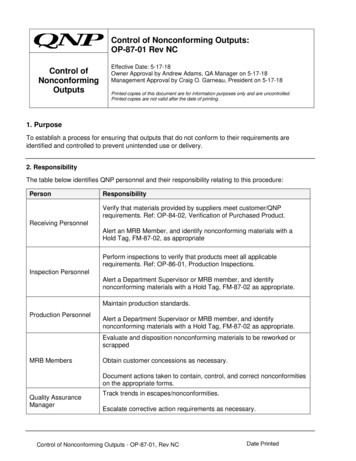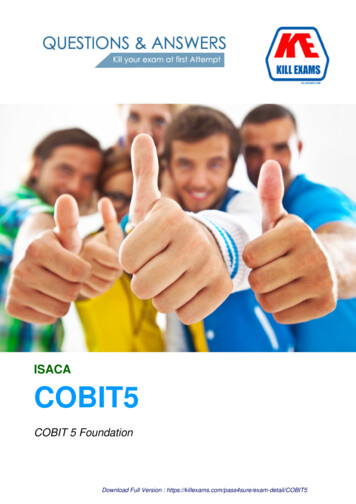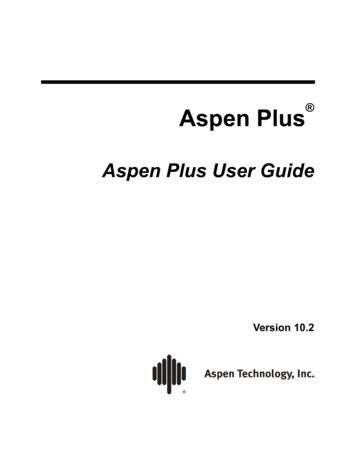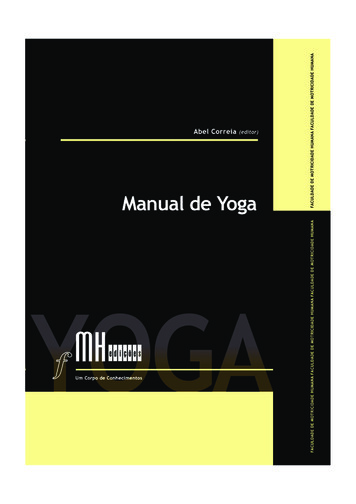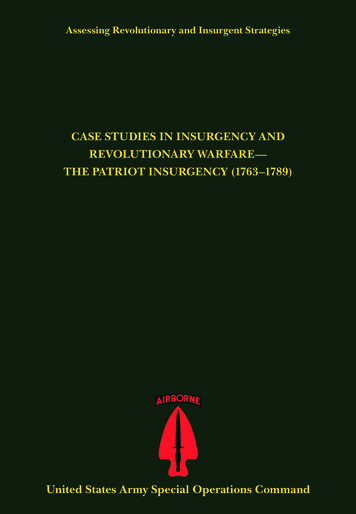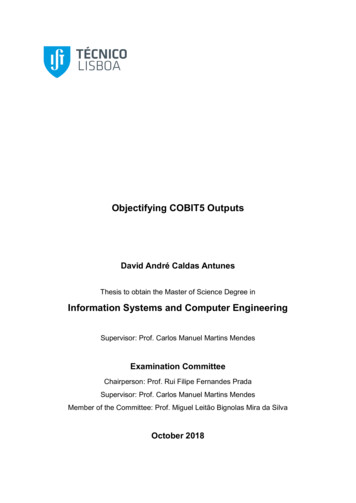
Transcription
Objectifying COBIT5 OutputsDavid André Caldas AntunesThesis to obtain the Master of Science Degree inInformation Systems and Computer EngineeringSupervisor: Prof. Carlos Manuel Martins MendesExamination CommitteeChairperson: Prof. Rui Filipe Fernandes PradaSupervisor: Prof. Carlos Manuel Martins MendesMember of the Committee: Prof. Miguel Leitão Bignolas Mira da SilvaOctober 2018
ii
AcknowledgmentsFirst, I would like to thank Professor Carlos Mendes for accepting my request for being my supervisor.His availability and readiness to provide feedback, suggestions and relevant documents were critical inthe realization of this thesis. I would also like to thank him for the support he provided by suggestingseveral contacts to me as potential experts for evaluating my research.I would also like to thank Rafael Almeida, Bruno Soares and Professor Paulo Faroleiro for theiravailability and for the help they provided in evaluating my research a giving me feedback to improvemy research and correct my mistakes.Last but not least, I would like to thank my friends and family for their support and for their advice.iii
iv
ResumoPalavras-Chave: COBIT5, Outputs, PAM, Work Products, ITIL.Esta tese tem como âmbito identificar e descrever os outputs produzidos pelos processos do COBIT5.Usando Design Science and Research Methodology como metodologia de investigação, foi identificadoum problema relacionado com a forma como o COBIT5 define e descreve os outputs gerados pelosprocessos. A abordagem do COBIT5 como guia de boas práticas assume que os praticantes deCOBIT5 tenham conhecimentos sobre o standard e sobre termos técnicos e estruturas organizacionaisde diversas áreas de negócio e sejam capazes de identificar em concreto os outputs produzidos pelosprocessos do COBIT5 usando informação relativa à organização que é alvo da avaliação decapacidades. A forma como os outputs do COBIT5 são descritos faz com que diferentes praticantescom diferentes níveis de experiência possam ter diversas interpretações e causar impacto no resultadode uma avaliação de capacidades referentes ao COBIT5. De forma a melhorar as descrições dosoutputs do COBIT5, foi feito um mapeamento dos outputs com descrições provenientes de outrosstandards de governança e gestão, bem como definições concretas quando estas não se encontramem standards estabelecidos.A avaliação dos objetos produzidos nesta investigação foi realizada recorrendo a profissionaisexperientes em COBIT5 e process assessment e as suas opiniões e comentários foram registados deforma a obter o máximo de informação sobre a viabilidade da solução e conhecimento gerado.Por fim foram retiradas conclusões sobre a solução proposta e o seu potencial impacto no processo deavaliação de capacidades de COBIT5 e da forma como o conhecimento gerado pode ser expandidopara os restantes processos do COBIT5.v
vi
AbstractCOBIT5 is a business framework that focuses on Enterprise Governance and Management of IT,providing a list of best practices that separates governance from management, allowing an efficientmanagement of critical business processes while also focusing on meeting the business stakeholder’sneeds. Due to the nature of COBIT5, the guidelines for implementing the required Enabling Processesare generic and designed to suit most organizations while not providing detailed information on how toproduce their respective outputs. The outputs’ description is often generic and requires the COBIT5practitioners to be familiar with terms and definitions that often are outside the scope of IT in order tofully understand what the COBIT5’s authors meant when the documentation was written. Using COBIT5and other established standards like ITIL as a foundation, we proposed a solution that objectifies anddescribes the outputs produced by the COBIT5 enabling processes by providing detailed definitions ofwhat the output is and where is should be found within the enterprise, improving the available knowledgefor COBIT5 process assessment. The gathered results were evaluated using the Pries-Heje et al.framework for DSRM and expert reviews. After the evaluation we concluded that is possible to extendthe descriptions of the outputs in a more objective form and how they relate to other definitions fromother established standards.Keywords: Enterprise Governance of IT, COBIT5, ITIL, Governance, Process Outputs, Work Products,Process Assessment, PAM, Self-Assessment, TOGAF, ISO.vii
viii
Table of ContentsAcknowledgments .iiiResumo .vAbstract .viiTable of Contents .ixList of Figures .xiList of Tables . xiiiList of Acronyms .xv1.2.Introduction .11.1.Context .11.2.Problem .11.3.Proposal .21.4.Evaluation .2Research Methodology .42.1.3.4.Process Model .4Problem .73.1.Contextualizing the Problem .73.2.Problem Definition .9Related Work .124.1.The role of Enterprise Governance of IT .124.2.COBIT 5 .124.3.4.2.1.COBIT 5 Enabling Processes .134.2.2.COBIT 5 Level 1 Work Products .144.2.3.COBIT5 Process Assessment Model .15ITIL .164.3.1.ITIL Service Strategy.174.3.2.ITIL Service Design .174.3.3.ITIL Service Operation .174.3.4.ITIL Continual Service Improvement .174.4.TOGAF .174.5.Mapping and Integration of Enterprise Governance of IT Practices.18ix
4.6.Using Enterprise Architecture for COBIT 5 Process Assessment and Process Improvement205.6.7.Proposal .235.1.APO04 – Manage Innovation .235.2.APO02 – Manage Strategy .275.3.Notable Work Product Mapping Examples .31Evaluation.356.1.First Iteration .366.2.Second Iteration.36Conclusion .397.1.Lessons Learned .397.2.Main Limitations .397.3.Future Work .40Bibliography .41Appendixes .43Appendix A – APO01 Work Product Mapping .43Appendix B – APO03 Work Product Mapping.47Appendix C – APO05 Work Product Mapping .50Appendix D – APO06 Work Product Mapping .54Appendix E – APO07 Work Product Mapping.59Appendix F – APO08 Work Product Mapping .63Appendix G – APO09 Work Product Mapping .67Appendix H – APO010 Work Product Mapping .71Appendix I – APO011 Work Product Mapping .76Appendix J – APO012 Work Product Mapping .80Appendix K – APO013 Work Product Mapping.85Appendix L – Typical Communication Plan Template .87x
List of FiguresFigure 1: DSRM Process Model [4] .4Figure 2: COBIT5’s Core Principles [5].7Figure 3: Level 1 Work Products .10Figure 4: Anatomy of an enabling Process [5] .13Figure 5: COBIT 5 process reference model [5] .14Figure 6: COBIT5 APO Level 1 Work Products [5] .15Figure 7: The ITIL Core .16Figure 8: TOGAF ADM phases .18Figure 9: ISO 27001 - ISO TS 33052/3307 - COBIT5 Metamodel[10] .19Figure 10: Generic ArchiMate template, for viewpoints used in COBIT 5 Process PerformanceAssessments[11]. .20Figure 11: Business Model Canvas (ref).27Figure 12: Guideline ArchiMate Model . Erro! Marcador não definido.Figure 13: RACI Chat ArchiMate Model. Erro! Marcador não definido.xi
xii
List of TablesTable 1: APO04 Work Product Mapping .23Table 2: APO02 Work Product Mapping .
enabler, COBIT includes a detailed description of the process, its activities, inputs, outputs and respective RACI chart. COBIT5 was designed to suit any organization, therefore the provided guidelines
